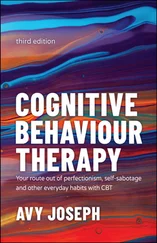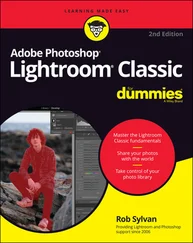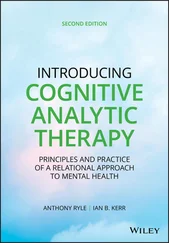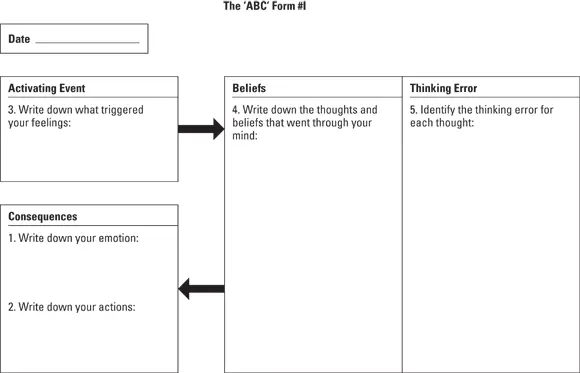
© John Wiley & Sons, Inc.
FIGURE 3-1:The ABC form I.
Creating Constructive Alternatives: Completing the ABC Form II
When you feel more confident about identifying your As, Bs, Cs and thinking errors, you can move on to the ABC form II. This second form helps you question your unhelpful thoughts in order to reduce their intensity, generate and rate the effects of alternative thoughts and focus on acting differently.
The first five steps for completing the ABC form II (see Figure 3-2) are the same as those for the ABC form I. Then come five more steps. You can find a blank version of the ABC form II in Appendix B. In the ABC form II, column A is the Activating Event, column B is Beliefs, column C is Consequences, column D is Dispute and column E is Effect.
1 Examine your negative thoughts more closely.Ask yourself the following questions in order to examine and weaken your unhelpful thoughts:Can I prove that my thought is 100 per cent true?What are the effects of thinking this way?Is my thought wholly logical or sensible?Do people whose opinions I respect agree that this thought’s realistic?What evidence exists against this thought?Is my thought balanced or extreme?Is my thought rigid or flexible?Am I thinking objectively and realistically, or are my thoughts being biased by how I feel? Consider long and hard your negative or unhelpful thoughts in the light of the preceding questions. Don’t simply give glib ‘yes’ or ‘no’ answers. Instead, think things through and perhaps write down your challenges to your unhelpful thoughts in column D. See the list of questions and prompters at the bottom of the ABC form II, which can help you further with this.
2 Generate alternatives for each of your unhelpful thoughts, attitudes and beliefs.This step is critical as it’s your alternative thoughts that will help you to feel better! In column D, write down a flexible, non-extreme, realistic and helpful alternative for each thought, attitude or belief that appears in column B. The following questions may help you to generate some alternatives:What’s a more helpful way of looking at the situation?Do I encourage friends to think in this way?When I’m feeling okay, how do I think differently?Have any past experiences shown me that another possible outcome exists?What’s a more flexible or less extreme way of thinking?What’s a more realistic or balanced way of thinking that takes into account the evidence that does not support my thought?What do I need to think in order to feel and act differently?Some thoughts are more stubborn than others, and you won’t turn your thinking around completely in one go. Wrestling with NATs for a while before they weaken is typical and appropriate. Think of yourself as training your mind to think more flexibly and constructively over a period of time. Some intrusive thoughts, images and doubts can be made worse if you engage with them. If you have obsessive-compulsive disorder (OCD), health anxiety, body dysmorphic disorder (BDD), worry or a jealousy problem, be sure to develop the capability to live with doubt, and allow catastrophic thoughts to pass through your mind rather than challenging them. We explain this in more depth in Chapters 5, 9and 13. So if you think you need to learn to live with doubt, or to tolerate upsetting, intrusive thoughts in general, we suggest steering clear of using ABC forms for these problems.
3 In column E, rate the effects of your alternatives on your feelings.Rate your original feelings 0 to 100 per cent. Also note whether you experience any alternative healthier emotions such as these:ConcernAnnoyanceSadnessRemorseDisappointmentSorrow© John Wiley & Sons, Inc. FIGURE 3-2:An example of a filled-in ABC Form II. You won’t always notice a great deal of change in how you feel at first, so keep persevering! Changes in the way you behave and think tend to precede improved emotional responses. Keep thinking and acting in line with how you want to ultimately feel.
4 Develop a plan to move forward.The final step on the ABC form II is to develop a plan to move forward. Your plan may be to conduct a behavioural experiment to help you gather more information about whether your thoughts are true or realistic, or to behave differently in a specific situation. Go to Chapters 4and 5for more ideas.
5 Set yourself some homework.When you’ve completed several ABC forms, you may well begin to notice recurring themes, thoughts, attitudes or beliefs. Such repetitions may suggest that you need to add some other CBT techniques such as the following in order to overcome certain emotions or behaviours:Facing a fear until it reduces ( Chapter 9)Conducting a behavioural experiment to test out a thought ( Chapter 4)AN ABC A DAY KEEPS THE DOCTOR AT BAY!If you want to develop any skill, remember these three words: Practice, practice, practice! You may not need to fill out an ABC form every day. Other days, you may need to complete more than one form. The point is that practising ABC forms regularly is worthwhile becausePractice helps change disturbing feelings and the thoughts that underpin them.Sinking a new thought into your head and heart takes repetition.By completing forms on paper, you can become increasingly able to challenge unhelpful thoughts in your head – although you may still need to do it on paper sometimes.As you progress in your ability to overcome difficulties and develop your CBT self-help skills, you may still find the ABC form useful when you’re hit with a biggie. And remember: If you can’t work out your unhelpful thinking on the hoof, do sit down and bash it out on paper.Acting repeatedly ‘as if’ you believe an alternative thought, attitude or belief ( Chapter 17)Completing a Zig-Zag form to strengthen an alternative thought, attitude or belief ( Chapter 17)Read on and set yourself some more therapy assignments using the CBT principles in this book.
 Keeping your old ABC forms can be a rewarding record of your progress, and a useful reminder of how to fill them in if you need to use one again in the future. Many of our clients look back over their ABC forms after they feel better and tell us: ‘I can’t believe I used to feel and think like that!’
Keeping your old ABC forms can be a rewarding record of your progress, and a useful reminder of how to fill them in if you need to use one again in the future. Many of our clients look back over their ABC forms after they feel better and tell us: ‘I can’t believe I used to feel and think like that!’
Chapter 4
Designing and Conducting Behavioural Experiments
IN THIS CHAPTER
 Testing out your thoughts and assumptions as predictions
Testing out your thoughts and assumptions as predictions
 Exploring theories and gathering information
Exploring theories and gathering information
 Designing and recording your experiments
Designing and recording your experiments
Often, CBT can seem like common sense. Behavioural experiments are particularly good examples of the common-sense side of CBT. If you want to know whether your hunch about reality is accurate, or your way of looking at something is helpful, put it to a test in reality.
This chapter is an introduction to behavioural experiments, a key CBT strategy. We include in this chapter an overview of several behavioural experiments that you can try out for yourself. We also give you examples of these experiments in action. As with the other examples we use in this book, try to look for anything useful you can draw from them. Try not to home in too much on how the examples differ from your specific problem. Instead, focus on what you have in common with the examples and work from there to apply the techniques to your own problems.
Читать дальше
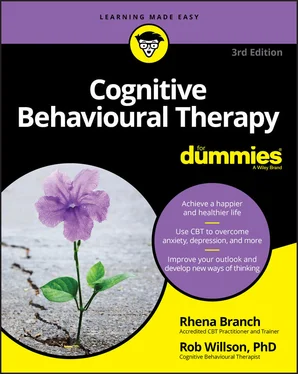

 Keeping your old ABC forms can be a rewarding record of your progress, and a useful reminder of how to fill them in if you need to use one again in the future. Many of our clients look back over their ABC forms after they feel better and tell us: ‘I can’t believe I used to feel and think like that!’
Keeping your old ABC forms can be a rewarding record of your progress, and a useful reminder of how to fill them in if you need to use one again in the future. Many of our clients look back over their ABC forms after they feel better and tell us: ‘I can’t believe I used to feel and think like that!’ Testing out your thoughts and assumptions as predictions
Testing out your thoughts and assumptions as predictions
